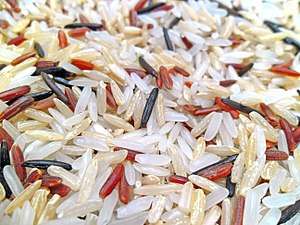IR8
IR8 is a high-yielding semi-dwarf rice variety developed by the International Rice Research Institute (IRRI) in the early 1960s. In November 1966, “the variety was first introduced in the Philippines and India.”[1] Promoters such as the IRRI and farmer benefactors of IR8 have called it miracle rice, and celebrate it for fighting famine.[2][3][4][5]
IR8 was the eighth of 38 crossbred rice varieties in a 1962 experiment by IRRI.[1] It was a cross of a high yield rice variety from Indonesia, Peta, and a dwarf variety from China, Dee-geo-woo-gen (DGWG).[1][2] The semidwarf-1 gene (sd-1 or Os01g0883800), which encodes an enzyme in the production of gibberellin and affects plant height, improved its yield.[6][7][8][1] IR8 was well suited to the places it was first introduced. However, it “did not fit most rice-growing situations,” which involve heavy monsoons or deep flooding.[4][5]
References
- 1 2 3 4 "IR8: Rice that Changed the World". IRRI.org. International Rice Research Institute. November 2016. Retrieved October 19, 2017.
- 1 2 Rowlatt, Justin (2016-12-01). "IR8: The miracle rice which saved millions of lives". BBC News. Retrieved 2017-01-02.
- ↑ Ganzel, Bill (2007). "The Development of "Miracle Rice" Varieties". www.livinghistoryfarm.org. Retrieved 2017-09-19.
- 1 2 Beyond IR8: IRRI’s second decade. International Rice Research Institute. April 1980.
- 1 2 Farmer, B. H. (1977). "1. Technology and Change in Rice-growing Areas". Green Revolution? Technology and Change in Rice-growing Areas of Tamil Nadu and Sri Lanka. Westview Press, Boulder, Colorado. pp. 1–6. ISBN 0-89158-709-8.
- ↑ "Os01g0883800". RiceWiki. Retrieved October 19, 2017.
- ↑ Nagano H, Onishi K, Ogasawara M, Horiuchi Y, Sano Y (October 2005). "Genealogy of the 'Green Revolution' gene in rice". Genes & Genetic Systems. 80 (5): 351–356.
- ↑ "Genetic Diversity in Rice". Food and Agriculture Organization of the United Nations Corporate Document Repository. Proceedings of the 20th Session of the International Rice Commission. Agriculture and Consumer Protection. 23–26 July 2002.
